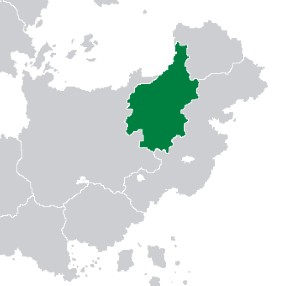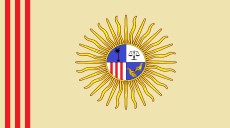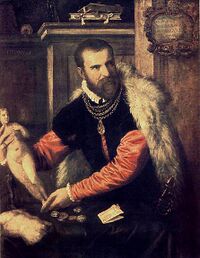Jossia
The Azzurri Republic of Jossia La Repubblica Azzurra di Jossia | |
|---|---|
|
Flag | |
| Motto: Unity in Strength | |
| Anthem: In Defense of Our Freedom | |
 Location of The Azzurri Republic of Jossia (in light green) within Asteria Inferior (light grey). | |
| Largest city | Tellaro |
| Official languages | Vespasian, Chanuche, |
| Ethnic groups (2019) |
|
| Demonym(s) | Jossian |
| Government | Federal Presidential Constitutional Republic |
• President | Irene Fornaciari |
• Vice President | Luca Tesconi |
• President of the Senate of the Republic | Gianni Ragavianno |
• President of the Chamber of Represenatives | Rapayet Pushaina |
| Legislature | National Congress |
| Senate of the Republic | |
| Chamber of Represenatives | |
| Independence from | |
• Colonization | 1543 |
• Independence | 1808 |
• Current Constutition | March 1993 |
| Population | |
• 2020 estimate | 33,192,786 |
• 2018 census | |
• Density | 515,683.84/km2 (1,335,615.0/sq mi) |
| GDP (nominal) | estimate |
• Per capita | |
| Currency | Jossian Dollaro (JSD) |
| Time zone | UTC-9 (UTC+15 (Western Lumine Time)) |
| Date format | dd.mm.yyyy |
| Driving side | right |
| Internet TLD | .jos |
Jossia, officially The Azzuri Republic of Jossia (Vespasian; La Repubblica Azzuri di Jossia), though more commonly known as The Republic of Jossia (Vespasian; La Repubblica di Jossia), is a sovereign country located in northeastern Asteria Inferior on Kylaris. Jossia is bordered by Satucin to her west, and Gapolania to the east, and has a maritime border with both nations on the East Arucian Sea. The population of the country is largely concentrated in the urban centers of the coast, with it being more rural and sparsely populated further inland. Jossia is a federal presidential constitutional republic, divided into 14 governorates and a capital domain of Tellaro, the country's largest city and main economic hub.
The country is composed of four main geographic regions Northwest Jossia is composed of a flat and fertile subtropical coastal plain. Further inland, to the south, elevation increases steadily and then plateaus, forming a region of high plains, or the Altipiano in Vespasian. Southwest of the Altipiano lies the Colline Rossa, a swathe of rugged hills. East of the Colline Rossa and Altipiano, the Sierra Bianca mountain range cuts through Jossia and forms the Grande Pianura savannas on the other side.
Modern Jossia was originally inhabited by the semi-nomadic Chanuche in the north and west and the Dabu in the eastern savannas. In the 1530s, the eastern side of Asteria Inferior became colonized by Povelian explorers, leading to the establishment of the Sassari colony, part of the Viceroyalty of New Povelia in 1578. Following the political revolutions in Etruria, Sassari declared its independence in X and faught in the First Secession War against the Viceroyalty and Etruria. The republic quickly fell into political instability after siding with the in the Great War. After the war, the country was led by a Sotirian religious wave before falling to a series of coups, alternating between democratization and dictatorships, the last being The Azzurri Revolution in 19 , leading to the creation of a new democratic government and a new constition.
Jossia is a high income, developing economy, with an HDI index rating of.77. Despite the accolades, the nation is dependent on industry and agriculture, particularly sugar, coffee, textiles, steel production, and crude petroleum. Jossia still struggles from a multitude of internal issues, including growing economic inequality, corruption, and environmental damage, and external issues, inlcuding drug trafficking at the Jossia-Gapolanian border. They are a member of the Community of Nations, International Council for Democracy, Asteria Inferior Common Market and Organization of Asterian Nations.
Etymology
The word Jossia is from Vespasian origin and means “holy lands.” According to historians, the name Jossia is attributed to Etrurian explorer Giacomo Borghese when his fleet sailed into the East Arucian Sea in 1538. The name Jossia was used in its official capacity after the beginning of the colonization process in 1543.
History
The Azzurri Republic of Jossia is the former colony of Etruria, having declared independence from the Etrurian First Republic in 1808.
Pre-Colonial Era
Before the arrival of Eucleans in the Asterias, modern day Jossia was inhabited by two major indigenous cultures: The Chanuche, west of the Sierra Bianca mountains, in the hill country and the fertile coastal plain, and the Dabu, the nomadic savanna dwellers east of the mountains. Within Chanuche culture, the Picunche people of the coastal plain were sedentary, and relied mainly on agriculture and fishing, cultivating maize, cassava, legumes, and other foodstuffs. The hill-dwelling Itaheuche were relied mainly on a mix of agriculture, llama husbandry, hunting and gathering, and were semi-nomadic. Both the Picunche and the Itaheuche produced silverwork, and elaborate textiles, and both were known to build earthworks and defensive fortifications to defend against rival communities. The Dabu hunted and gathered on the savannas and waterways beyond the mountains, and had no fixed settlements.
A Poveglian fleet led by explorer Giacomo Borghese first sailed into Jossian waters in 1538 and began trading with the indigenous Chanuche over the next decade. Trading centers led to the spread of new animals including horses, cows, sheep, and metal tools throughout the region, initiating the shift to a herding society.
Colonial Era
In 1543, Governor Carlo Amoretti established the the first settlement in Jossia, the port town of San Rosa. Its 200 settlers first established trading relations with the coastal Picunche and shortly after the slow diffusion of Euclean animals and products moved into the Jossian interior, which would eventually lead to the integration of horses into the Huilliche culture. In 1545, the colony of Astia was founded in modern day Gapolania. Further east, Nassea was established in 1549 by another Povelian fleet. Together they formed the Tricolony, centering administrative power around the three towns. The arrival of the Poveglians introduced Sotirianity but also smallpox and other diseases, resulting in what was called the “Great Dying” by the indigenous people. Both inland and coastal settlements were quickly stricken with disease, leaving most societies vulnerable to Governor Amoretti’s future plans.
As the Governor expanded settlements, relations between the Picunche and settlers grew tense. Picunche towns, stricken from the Great Dying, were stripped and resettled by Poveglians looking for an easier start. Religious sites were desecrated and graves were robbed, angering the Picunche who survived. Frontiersmen pushed further inland, looking for mineral-rich farmland and settled in abandoned houses. Several settlements pressed Picunche women and children who survive into servitude. The tension turned violent in 1551 in what was called the First Sarrarian War, a conflict between the settlers and a Picunche and Huilliche coalition that led to open war, leaving thousands of native men, women, and children dead. After three years of brutal warfare, settlers took Picunche for slaves or concubines, but many refused to submit to the Poveglians, and were either killed or pushed inland.
The rugged hill country of Jossia’s interior made it nearly impossible for the Poveglian settlers to control the Colline Rossa. The earlier trading of horses and weapons to the native population provided an advantage to the Huiliche that the Picunche lacked. The colony’s reliance on slave labor kept the population of Sassarians low, which limited their ability to build a force large enough to control the Colline Rossa. This resulted in Huiliche troops fighting Sassarian forces to a draw in the Second Sessarian War, a consistent set of skirmishes between 1562 to 1564. Despite the war, Sassarian frontiersmen traded with some inland Itaheuche tribes but battled others throughout this time. Poviglian maps were drawn to show the inland hills and plains were part of the colony, but control of those lands changed with the season.
With expectations from Poveglian investors growing each season, the need for lucrative cash crops like sugar and coffee were especially profitable, with cotton and tobacco creating secondary engines of production for the colony. In 1579, the Tricolony centralized its power to form the Viceroyalty of New Povelia, a subordinate of the Povelian Doge that had direct power over the colony. The Viceroyalty was divided into three governorates with the Governorate of Sessaria constituting a part of modern-day Jossia. The cash crops created a great need for labor and the colony quickly moved to indentured servitude with the Picunche and Hiilliche, but their numbers were limited having driven the majority of them south. In 1583, the first of more than 100,000 slaves arived from Bahia. Povelian merchants and Sessarian elites grew rich from chattel slavery working on their latifundia. By 1631, Sessari was recognized as an export-oriented slave society, destroying generations of overworked slaves for more than a century and a half.
Etrurian politics shifted ownership of the Tricolony and with it Sessari over the decades, but the need to support the colonial cash cow was always a priority. In time, Etrurian authorities allowed freedmen and Razzamista to move into the rugged hills of the Colline Rossa in an attempt to disrupt Huilliche power. However, the Bahio-Asterian developed a positive trading relationship with the Huilliche villages, devoid of hostility. The hill country was once again out of reach to the Sessari government. However, with the steady stream of meat, wool, hides, and other goods that the Bahio-Asterian brought down from the Huillite lands meant that the elite benefitted from the exchange, and colonial authorities turned a blind eye to their activities. Agriculturalists and their merchant backers had realized that a plantation agriculture was unsuitable for Colline Rossa, and therefore the need to subjugate those lands were not worth the time and money. For the majority of its colonization, Sessarian power did not extend beyond the highlands and the northwestern mountains. Early mining in the northern Sierra Biana mountains created a number of settlements that would be future industrial hubs of Jossia. Authorities in Telloro would not discover the safe route through the Sierra Biancas until fifteen years after the revolution.
In colonial Sessari, the Vespasian ruling class maintained a racial hierarchy throughout its existence. Etruriani, or white Vespasians that were born in the homeland, formed the upper echelon of the colonial world. Below them, the creolo, or white Vespasians who were born in the colonies, formed a less powerful, wealthy, privileged class. The next level were the Razzamista, including Bahio-Eucleans and Picuncho-Eucleans, many of whom were freeborn landowners, but who were considered lesser than the white population and relegated to a lower social standing. The lowest ring of the social order were two groups, the indentured Picuncho servants and the nero, or enslaved Bahians, who formed the overwhelming majority of the colonial population. Given the horrible conditions on the plantations, escape attempts from both the nero and Picuncho servants were common, and escaped slaves or chilombiano were known to flee south into weychanmachi-controlled chilombi, fortified settlements in the Colline Rossa far beyond the reach of colonial authority.
The growing disparity between the Euclean colonizers and Bahian or idigenous groups led to a rise in the Pantheonisti movement, an ideology that supported equality, freedom, and liberty, which was widely popular with both the poor and the creolo, but for different reasons. Starting in Etruria, the idea gained a foothold in the creolo social class in 1785 after two priests, Giacomo Sandera and Lozano Bigantú wrote Heavenly Asteria (Asteria Celeste), advocating for an independent religious state in Asteria and a way to break away from the Etruriani and their colonial overlords. While the push for a religious state failed rather quickly, the Sessari colony declared independence from the Etrurian First Republic in 1808, with Gapolania and Semaria quickly following suit. The Eutrurian monarchy officially recognized the independent Sessari state, which was newly named Jossia.
The First Republic
The Second Republic
Great War
Solarian War
Late 20th Century
Jossia has dealt with short-lived governmental changes in the late 20th century leaving a wake of state-sponsored terrorism and corruption that stained the soul of the nation. After the market crash of 1968, Jossia suffered from a financial fallout that included corporate bankruptcies, leading the nation into a recession. Within a year, the nation struggled with mass unemployment, food shortages, and public riots throughout the nation. General Benito Maltoni came to power in 1969 after aligning himself with Admiral Alfredo Candia in a military coup that overthrew the struggling President Carlos Bresciani in his last year of office. To pull the nation out of crisis, Maltoni simplified the tax code, cut taxes, curbed foreign spending, and created a massive public works program in an effort to modernize the economy. There was also a state takeover of strategic industries, notably oil and steel, to improve the nation’s strategic resources. In three years the economy grew more than 25 percent and unemployment fell 74 percent, but the program more than doubled the national debt.
Government intervention in industry was very uneven as Maltoni’s public works programs were only directed to expand its manufacturing sector, and quickly lacked direction elsewhere. A poor harvest during Maltoni’s second term in 1975 led to a grain crisis where government intervention provided subsidies for domestic growers but also cut spending and importation, creating widespread inefficiencies and food shortages throughout the nation’s urban areas. The move enraged many and pushed Maltoni to look outside for support.
Maltoni pushed his reign into a third term using strong arm tactics that led many to question a legitamatacy of the election. In the midst of an Asterian_Spring, the people of Jossia started to rise up in protest of the growing inequality in the state. The Azzurri, or Blue Coats, were the chief organizers of protests and led riots in all major cities throughout Jossia. Fearing his life, Maltoni ruled with an iron fist, consolidating his power and slaughtering dissidents in the name of progress. His downfall came in 1982, when Maltoni ordered his troops to open fire on a Mapuche village after Jossia’s intelligence agencies suspected an attempt to blow up the Presidential Compound in Calabrimo. The wholesale murder of the village triggered an outrage from the nation and Asteria. The Azzurri led Jossians in a revolution to oust Maltoni and bring peace back to the nation. Led by future President Antonio Quarenta, the Azzurri Revolution of 1983 against Maltoni’s government was a bloody, but successful, war for freedom. After the revolution, the support of the Azzurri was so strong across the nation, the state was renamed in their honor.
The Third Republic
Now, a progressive state in its 18th year of pink tide, Jossia’s left-wing government continues to right the wrongs of its past, prosecuting human rights violators and paving the way for industrial growth, creating fiscal and trade surpluses to pay down debt.
Geography
Climate
Environment
The country is composed of four main geographic regions North Jossia is composed of a flat and fertile subtropical coastal plain. Further inland, to the south, elevation increases steadily and then plateaus, forming a region of high plains, or the Altipiano in Vespasian. Southwest of the Altipiano lies the Colline Rossa, a swathe of rugged hills. East of the Colline Rossa and Altipiano, lies the Sierra Bianca mountain rangem which cuts through Jossia and forms the eastern savannas of the Grande Pianura.
Government
Constitution
Executive
Legislative
Judicial
Elections
Foreign Affairs
Political Parties
Administrative Divisions
Military and Law Enforcement
Trying to erase its corruptive, militant past, Jossia restructured its military and limited its power at the start of the 21st century. In 2003, Jossia enacted the Defense Law, which set to modernize the armed forces only for the use against foreign aggression, cease conscription laws enacted in the 1980s to lessen the size of each branch,limit the powers of each Branch’s leaders, and centralize operations under the authority of the President’s Joint Forces General Staff. The Jossia Armed Forces now consist of three professional volunteer branches, Army, Navy, and Air Force.The main focus of the current military is to continue to modernize and provide humanitarian aid along with protection of the region's waterways. The total active personnel in the Armed Forces is 169,000 and its current budget has decreased to 1.6% GDP. [list] [*]Army: 102,000 personnel [*]Navy: 49,000 personnel [*]Air Force: 18,000 personnel[/b] [/list]
Economy
Jossia is a developed nation with a mixed market economy supported by primary industries of oil and metals. The nation possesses a developed industrial sector that provides numerous goods for the Asturian markets, like food processing, textiles and apparel, and tertiary industries in transportation and electronics. A growing number of the nation’s energy supply comes from renewable resources (12%) but Jossia’s oil industry maintains a strong grasp on energy production and consumption. The nation is considered a low middle-income country and ranks well in economic freedom, but struggles in income equality. Jossia is moving towards becoming a socially progessive country, with heritage protection programs for its indigenous population and Equal Marriage Laws, but is still struggling to push the needle further left. Urban centers make up 82% of the population. Jossia is a middle power, a regional power, and a member of various international organizations, including the Community of Nations, International Council for Democracy, International Trade Organization, the Organization of Asterian Nations, the Asteria Inferior Common Market, and the League of Oil Producing States
Energy
Jossia is leader in energy production in Asteria Inferior. They have the fourth largest oil reserves and the second largest coal reserves after Nuvania. It is the second largest producer of coal and crude oil within Asteria Inferior, which contributes approximately J$X to the economy annually..
Jossia produces X barrels of oil per day, with an annual production value of J$X. The nation produces $JX worth of petroleum, and J$X worth of fuel oil annually. Most of these products are produced in refineres located in the Basilicala region of Jossia, in particular in the Flumicio Refinery with a production capacity of 390,000 barrels per day. Jossia has three oil refineries located around the state, with the Asterian Oil Corporation (AOC) and the JosOil Company being the largest operating in the state.
Jossia produces X million tons of coal worth J$ annually, with coal production accounting for X% of total fuel production and X% of fuel exports. A majority of the coal is consumed for domestic electritcity geeneration, with exports to Asterian countries acccounting for the remainder of production. Ghiottone and Andrisani are two of the largest companies that operate coal mines in Jossia.
Nuclear energy first made its appearance in Jossia in the 1960s when the nation established a government organization to explore and develop nuclear power. Today, there is only one nuclear reactor in Jossia, the 418 MW SessaUno, a pressurized heavy water reactor that entered commercial service in 1978. After the coup of 1984, Admiral Maltoni announced that Jossia had the capability to produce weapons grade uranium, but the nation has yet to build the facilities to do so or provided evidence they could. Since the Azzurri Republic, Jossia has pledged to use nuclear power solely for peaceful purposes. The nation is a proponent for non-proliferation and is highly committed to global nuclear security.
Manufacturing
Mining
Services
Agriculture
Infrastructure
Science and Technology
Nuclear energy first made its appearance in Jossia in the 1960s when the nation established a government organization to explore and develop nuclear power. Today, there is only one nuclear reactor in Jossia, the 418 MW SessaUno, a pressurized heavy water reactor that entered commercial service in 1978. After the coup of 1984, Admiral Maltoni announced having the capability of producing weapons grade uranium, but the nation has yet to build the facilities to do so or provided evidence they could. Since the Azzurri Republic, Jossia has pledged to use nuclear power solely for peaceful purposes. The nation is a proponent for non-proliferation and is highly committed to global nuclear security.




![thumb]The Topography of Jossia](/mediawiki/images/thumb/9/9b/Jossia_blank_topography.png/300px-Jossia_blank_topography.png)